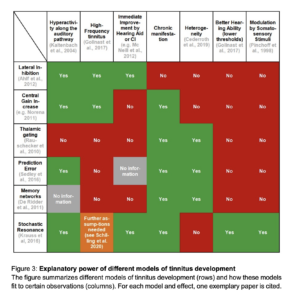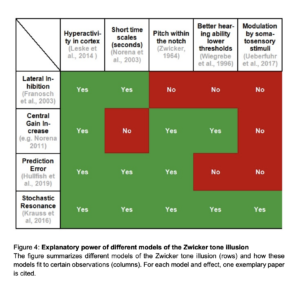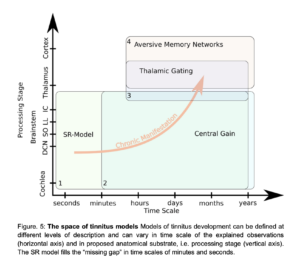This new paper titled, The Stochastic Resonance model of auditory perception: A unified explanation of tinnitus development, Zwicker tone illusion, and residual inhibition, is a must-read for anyone interested in a fascinating “big picture” explanation of tinnitus.
The 25-page PDF document (see link below) is a pre-print that is dated March 27, 2020. A “pre-print” is a paper that has not yet been published and has not yet gone through the peer review process. Think of it like an “unofficial” copy of a paper that is waiting to be published and must still be verified.
Here is the link to the PDF of the paper:
https://www.biorxiv.org/content/10.1101/2020.03.27.011163v1.full.pdf
Despite the pre-print status, it is worth sharing because it offers insight into the fundamental nature of tinnitus, including its various causes, why it’s hard to tell why tinnitus gets worse for some people but not for others, and… best of all… as the title mentions, this paper includes a a “unified explanation” of tinnitus development. A “big picture” model that could explain all the other models, and bring them together.
Here are some of the “big picture” visuals you will find inside:



The authors outline many of the current and widely-studied tinnitus models and theories. They describe how these models are similar, how they are different, and point out the apparent contradictions. And then they explain how all these models may fit within an even bigger model: a “big picture” theory and explanation of tinnitus – in many of its various forms – that is based on something called stochastic resonance (SR). (For more background on SR: see this post from May 14, 2019, which describes the SR model of tinnitus.)
As the authors mention, the study does have its limitations. The theory does not literally explain everything. But it lays some solid groundwork and provides new direction for researchers to continue their search for an “everything” model of tinnitus that has both explanatory and predictive power. Solid progress!
It appears that a serious amount of research and consideration went into creating this work, which draws from 122 relevant papers, many of which are quite recent. (In other words, this is NOT simply “recycled” theories from years ago, or a lazy, unoriginal review. It is the exact opposite!)
A unified explanation of tinnitus development… worthy of the community’s spotlight?
It is now up to the tinnitus community to decide if they wish to discuss stochastic resonance and highlight the work of Schilling et al to make sure high-quality research like this gets the attention it deserves. (Remember, if promising research gets ignored… if promising research does not get attention… the funding dollars will either dry up, or – if history is any indication – be swallowed by “mainstream” studies involving TRT, etc. So, do your part and share original research! The community’s attention can be a remarkably powerful force in steering the direction of future research.)
Acknowledgements: A special thank you to the team of authors responsible for this noteworthy research: Achim Schilling, Konstantin Tziridis, Holger Schulze, Patrick Krauss.
The Stochastic Resonance model of auditory perception: A unified explanation of tinnitus development, Zwicker tone illusion, and residual inhibition
Achim Schilling, Konstantin Tziridis, Holger Schulze, Patrick Krauss
bioRxiv 2020.03.27.011163; doi: https://doi.org/10.1101/2020.03.27.011163